Abstract
INTRODUCTION
Easy access and availability of communication tools have facilitated doctors’ communication, adding new challenges. Through this study, we aimed to determine the profile of the knowledge and practices of doctors in our institution, and to identify knowledge gaps in the use of social media accounts.
METHODS
An anonymous survey was sent by electronic mail in March–May 2018 to 931 doctors working in National University Hospital, Singapore. It included questions on demographics; use of social media; and case-based scenarios involving professionalism, patient-doctor relationship and personal practices of social media use.
RESULTS
The response rate was 12.8%. The majority of the respondents owned a social media account (93.3%), had not received education on social media use in medical school (84.0%), did not own a separate work phone (80.7%) and claimed to have no medical education on this as a doctor (58.8%). Unawareness of the institution’s social media policy was reported by 14.3% of the respondents. Questions on knowledge of the privacy settings of their account were incorrectly answered. Only 75.6%–82.4% of the participants responded ‘no’ when asked if they would post pictures of patients or their results, even if there were no patient identifiers.
CONCLUSION
There is inadequate knowledge regarding institutional social media policy and privacy settings of social media accounts among doctors. Regarding practices in social media use, while most agree that caution should be exercised for online posts involving patients, ambiguity still exists. The emerging knowledge deficit and potentially unsafe practices that are identified can be addressed through continuing medical education and training on social media use.
INTRODUCTION
Social media is described by Kaplan and Haenlein(1) as “a group of Internet-based applications that build on the ideological and technological foundations of Web 2.0, and that allow the creation and exchange of user-generated content”. Internet-based applications refer to the different categories of social media, i.e. blogs, content communities, social networking sites, collaborative projects, virtual game worlds and virtual social worlds. The use of social media has drastically increased over the last few years, with over two billion active Facebook users and an estimate of more than 300 million active users of Twitter.(2)
Awareness of social media and its use in healthcare has become more established in recent years. Easy access and availability of communication tools have enabled more efficient communication of doctors within and outside of their practice. While this has created more opportunities for collaboration, it is not without its challenges. Social media has made it more difficult for physicians to maintain a clear line between their professional and personal lives. Healthcare workers have been disciplined for inappropriate online postings.(3)
The Singapore Medical Council (SMC) laid out new guidelines on social media use for medical professionals under the updated SMC Ethical Code and Ethical Guidelines (ECEG), effective from January 2017. Things that doctors should not do, both online and offline, have been clearly stated. The ECEG comes with examples listing the entire range of possible inappropriate behaviour on social media, such as appearing intoxicated, engaging in lewd or inappropriate behaviour and posting personal or derogatory comments about patients or colleagues.(4)
We sought to study the prevalence of social media use, and describe the current profile on knowledge and practices of doctors in our institution regarding the use of social media. We focused on the use of social media accounts such as Facebook, Twitter and Instagram, and instant message applications such as WhatsApp and Snapchat.
The primary aim of this cross-sectional study was to highlight the current social media climate among doctors working in a tertiary unit in Singapore in order to gain a better understanding of the current knowledge and practices of this group of doctors. This would, in turn, help to identify gaps in the proper use of social media. This knowledge would shape the planning and implementation of educational curriculum for our doctors in the use of social media as social media use becomes more ubiquitous within healthcare practice.
METHODS
Our study design was a cross-sectional survey. An online voluntary anonymous survey was sent out via electronic mail to 931 practising doctors working in National University Hospital, Singapore. The survey was disseminated through the work email accounts of department secretaries to the doctors’ work email, with one reminder email sent at fortnightly intervals. The study was conducted from 1 March 2018 to 31 May 2018. The results of the survey were compiled via Google Forms, an online survey tool.
It was emphasised at the start of the survey that a doctor’s refusal to participate in the study had no bearing on his/her clinical work or assessments and that the study was solely for research purposes. Implied consent to use the data provided to the study team was assumed when a doctor completed the survey. Doctors were also given the option to skip questions that they were not comfortable answering or to abort the survey completely. The study was reviewed and approved by the National Healthcare Group Domain Specific Review Board (study reference number 2018/00094).
The survey contained questions pertaining to doctors’ knowledge of their social media account privacy settings. This included case-based scenarios involving professionalism, patient-doctor relationship and personal practices of social media use to understand their social media practices. It also contained questions that assessed their engagement in social media and privacy concerns using a three-point Likert scale. As there was no available validated scale to assess social media use, this survey was developed after the questions were deliberated on among the investigators and after a preliminary survey was conducted to collect feedback from doctors regarding their concerns about social media use. These questions were chosen to reflect the breadth of possible uses, and framed in the context of personal and professional usages. The survey was piloted to check for its ease of use and readability before it was sent out.
We decided that a knowledge gap in more than 20% of the population is of practical significance. Hence, we calculated that approximately 106 participants would be needed for this study in order to demonstrate a 20% difference, based on a two-sided significance alpha level of 5% and 80% power. Descriptive statistics such as personal demographics, including age, gender, duration of practice, work designation and specialty of practice were obtained. Chi-square test was used to compare the responses between different demographic categories using IBM SPSS Statistics version 23.0 (IBM Corp, Armonk, NY, USA), and the statistical significance was set at p < 0.05.
RESULTS
A total of 931 invitations to participate in the survey were sent out, of which 119 (12.8%) surveys were completed and returned.
Table I
Demographic details of the study participants (n = 119).
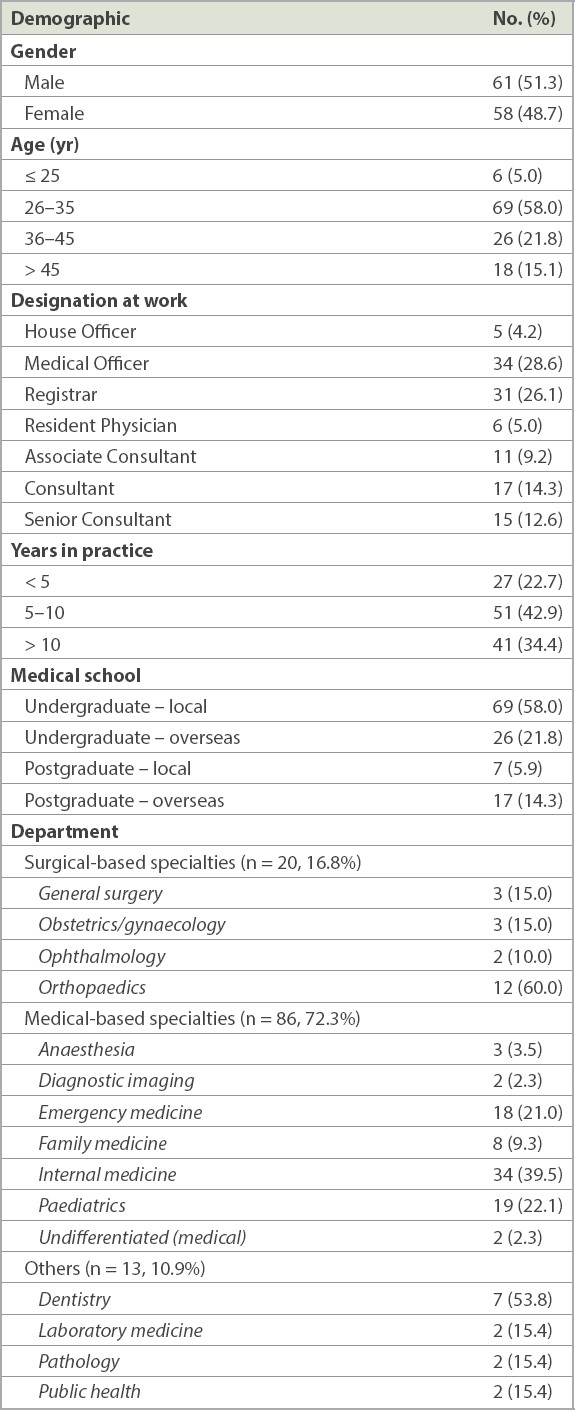
Table II
Use of online social media accounts (n = 119).
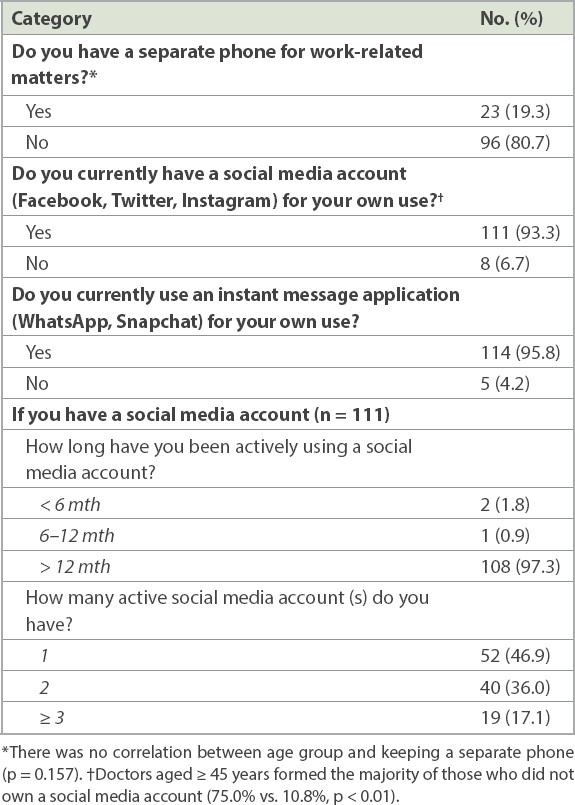
Most (85.7%) doctors claimed that they were aware that the institution had a social media policy. However, a large number (84.0%) reported that they had not received education on the use of social media in medical school. More doctors who had graduated from an overseas undergraduate programme reported having received education on social media use as compared to those who had graduated from a local medical school (42.1% vs. 18.0%, p = 0.032). More than half of the cohort (58.8%) denied having received any continuing medical education or instructions on social media use in their postgraduate years (
Fig. 1
Chart shows participants’ knowledge of social media policy or education. *Those who had graduated from an overseas undergraduate programme reported having received education on social media use compared to those who had graduated from local medical schools (42.1% vs. 18.0%, p = 0.032).
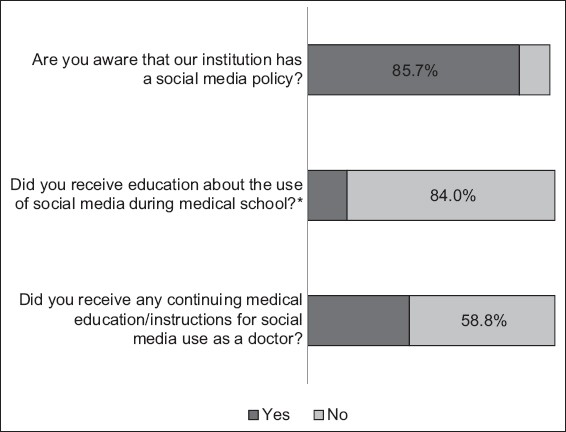
Among doctors who owned a social media account (n = 111), 95.5% and 77.2% claimed that they understood the settings of their social media account and instant messaging application, respectively. However, specific questions posed to test their knowledge of social media account settings yielded heterogeneous answers. Only 66.7% of the doctors knew that they could prevent a person/patient from searching for their social media profile. Also, 38.7% responded incorrectly that anyone could search for them on their social media account regardless of the privacy setting. While most (86.5%) knew that it was possible to change settings to control who could tag them on a photo/image, a small number of participants (13.5%) did not think this was possible; more doctors aged ≤ 35 years answered this question correctly compared with those aged > 35 years (91.9% vs. 75.7%, p = 0.035). Approximately half (55.0%) of the doctors responded incorrectly that they could permanently delete a post or other material they had posted on their social media account (
Table III
Knowledge of social media account privacy settings (n = 111).
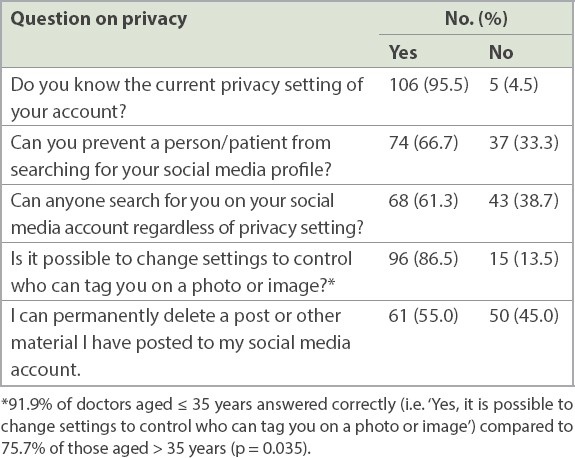
Table IV
Practices in the use of instant messaging application (n = 114).
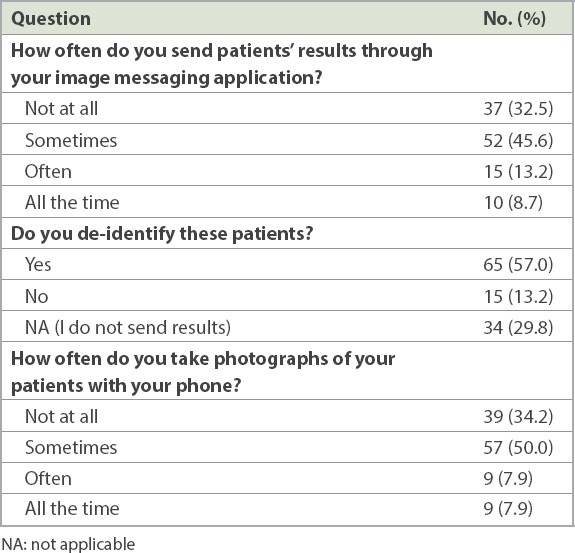
Regarding social media use, 75.6% and 82.4% of the cohort felt that it was unacceptable to post photos and radiological images of patients on their social media accounts, respectively. 78.2% would not accept a friend request from a patient. One in five (22.7%) respondents felt that it was acceptable to access their social media account while on duty, while 52.1% disagreed and 25.2% were uncertain whether this was appropriate. 60.5% of the respondents felt it was inappropriate to post work victories on their social media account, while 39.5% would consider doing it. In terms of collegiality, 70.6% felt that it was professionally acceptable to post a photo with colleagues at a department event on their social media account. About one-third (37.8%) felt it was acceptable to post a photo of colleagues drinking alcoholic beverages at a social event (
Table V
Practices in social media use in specific scenarios (n = 119).
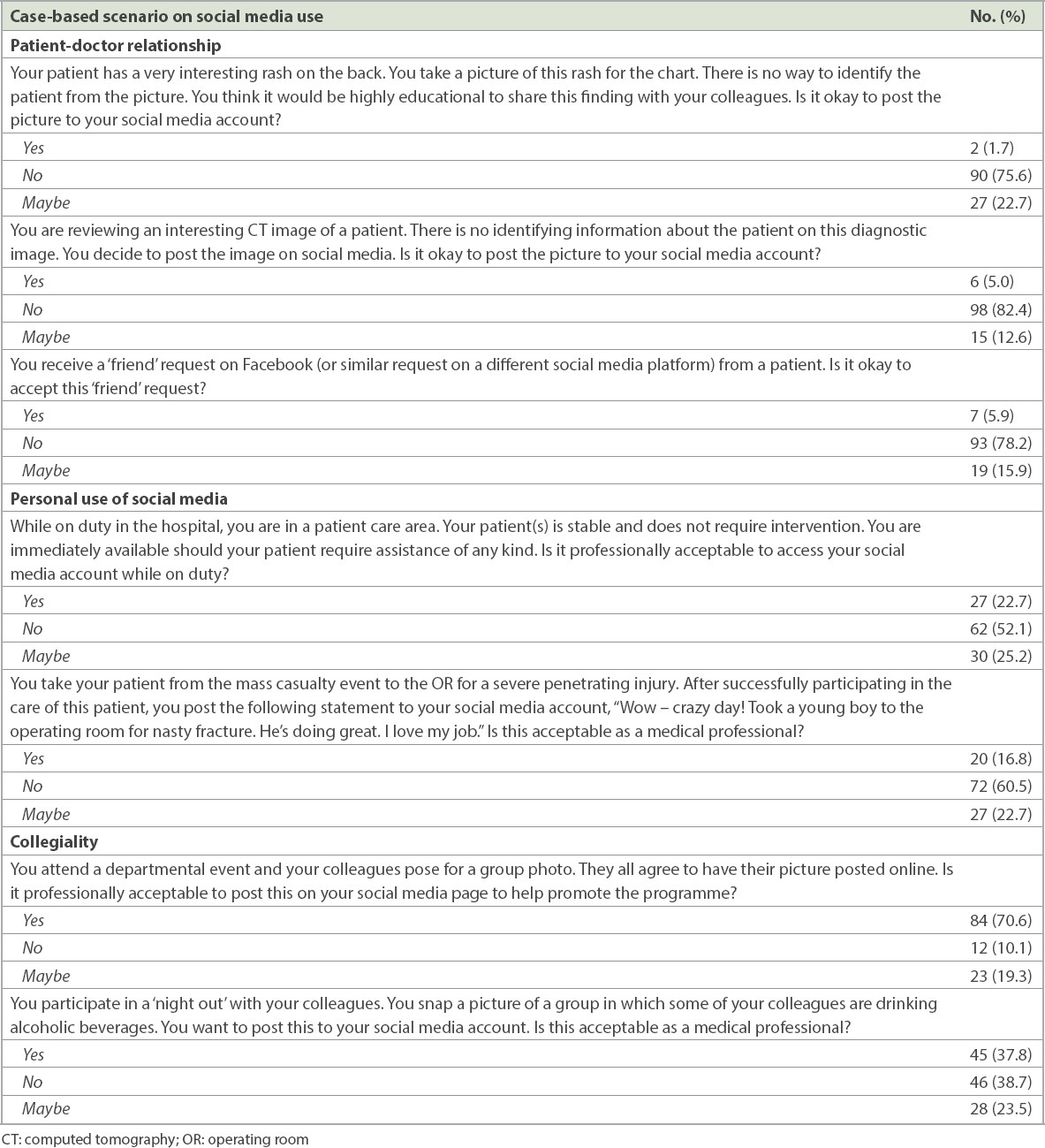
DISCUSSION
Not surprisingly, 95%–97% of the doctors in our institution owned a social media account, which is similar or slightly higher than the proportion reported in other studies.(5) Other studies have shown that the use of social media was less prevalent among older doctors, and most social media users were under the age of 30 years.(6) In our study, the majority of those who did not own a social media account comprised doctors aged 45 years or older (75.0% vs. 10.8%, p < 0.01).
Our results suggest that there is a knowledge deficit in terms of understanding of the privacy settings of social media accounts. When asked specific questions regarding this, 30.0%–55.0% of the respondents had an incorrect understanding of their social media account settings despite 95.5% claiming that they were aware. This knowledge is important to avoid privacy breaches of confidential information, especially if these doctors post material about their patients online. This lack of knowledge of social media privacy settings mirrors that of other studies that were conducted in medical professionals whose patients’ privacy was violated owing to unawareness of ethical implications.(7-9) Being unaware of privacy settings could also allow patients to search for doctors online and access their personal information. A previous study showed that most doctors were not comfortable with a patient who had accessed information about them online prior to the consultation.(5) Understanding privacy settings is also important to ensure that content for private access does not become public, and this is one of the key guidelines proposed by Guseh et al.(10) Similarly, most doctors would not be comfortable accepting a ‘friend’ request from their patients. This practice is consistent with that reported in other studies.(5,10)
Although guidelines on social media use can be found in the SMC ECEG, our study found that there is much heterogeneity in social media-related knowledge among the doctors surveyed. The majority (84.0%) claimed to not have received education on social media use in medical school. As the doctors surveyed had already been working for 5–10 years, the lack of education on social media use might reflect a lower emphasis on social media in the past. A significant number (58.8%) had also not received education on this important topic during their postgraduate training.
In the case-based scenarios, we identified considerable ambivalence among doctors regarding their social media practices. Although some doctors would post online material related to work, most agreed that they need to exercise caution, especially if there is patient involvement. This study raises important questions related to the appropriate use of social media in our local healthcare settings amidst an increasingly litigious society. Although there are official general guidelines available to address these questions, in practice, it is impossible to formulate similar guidelines for all possible usage scenarios given the broad application areas and involved stakeholders.
We have noticed a trend that favours social media use for medical education purposes (e.g. posting a de-identified picture of a rash for educational purposes). Social media use in medical education has shown some promise in promoting learning among junior doctors owing to its ease of use and fast communication of information.(11) However, its use in medical education worldwide remains challenging owing to concerns about medical professionalism.(12)
Indeed, the use of social media by doctors remains ambivalent. We speculate that this may be attributable to concerns about liability, litigation and privacy. However, it is undeniable that opportunities are present for doctors to use these vast social networks to improve healthcare efficacy and the well-being of patients. Perhaps, instead of complete abstinence, the best way forward is to stay abreast of the changing privacy settings of social media sites so that users can protect their private information. We propose continuing medical education to fill this knowledge gap and equipping our doctors to better deal with social media use, which is likely to be increasingly integrated into medical practice. We recognise that there may not be clear answers for some of the questions posed, but case-based discussions/interactive sessions in small group settings could be useful.
There are limitations to our study that merit consideration. This is a single-centre survey, and the response rate raises the potential for acquisition bias. The response rate of 12.8% may not be reflective of the rest of the population of doctors; as we do not know the views of the non-responders, the potential for non-response bias exists. Further, the survey was conducted online, which might have resulted in a biased cohort that favours technology.
In conclusion, this cross-sectional survey describes the current knowledge and practices regarding the use of social media by doctors working in a tertiary hospital in Singapore. It underlines the ongoing need to improve doctors’ online knowledge and capabilities, refine guidelines and continuing medical education, and increase awareness on this matter, as social media will continue to be increasingly ubiquitous and integrated in healthcare. In view of the potential for severe professional repercussions, we propose that all medical professionals who use social media must have no or minimal gaps in knowledge or ambivalence in both personal and professional social media practices.
ACKNOWLEDGEMENT
We thank Dr Dimple Rajgor for her assistance in editing, formatting, reviewing and submission of the manuscript for publication.


